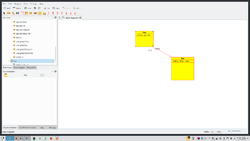Umbrello: Difference between revisions
(Created the entry.) |
(website link updated) |
||
| (25 intermediate revisions by 7 users not shown) | |||
| Line 1: | Line 1: | ||
<languages /> | |||
UML allows you to create diagrams of software and other systems in a standard format ([http://www.uml.org/]). | {|class="tablecenter vertical-centered" | ||
|[[Image:Umbrello2.png|250px|thumb]]||<translate><!--T:1--> | |||
'''Umbrello UML Modeller is a Unified Modelling Language (UML) diagramming tool from KDE'''</translate> | |||
|} | |||
<translate> | |||
<!--T:2--> | |||
'''UML''' allows you to create diagrams of software and other systems in a standard format called '''Unified Modelling Language''' i.e. '''UML''' ([http://www.uml.org/ www.uml.org]). | |||
Existing code files | <!--T:3--> | ||
Content of diagrams can be exported into code. Existing code files can be parsed and imported to be used in diagrams. | |||
<!--T:4--> | |||
The following diagram types are supported: | The following diagram types are supported: | ||
* use case diagram | * use case diagram | ||
| Line 16: | Line 23: | ||
* deployment diagram | * deployment diagram | ||
* entity relationship diagram | * entity relationship diagram | ||
<!--T:5--> | |||
The '''Umbrello''' home page is at [http://umbrello.kde.org umbrello.kde.org]. | |||
The source code can be found on the [https://projects.kde.org/projects/kde/kdesdk/umbrello/repository umbrello git repository] as part of the '''kdesdk''' package. | |||
Screenshots are found on [http://umbrello.kde.org/screenshots.php this page]. | |||
<!--T:6--> | |||
Mailing lists are: | |||
* [https://mail.kde.org/mailman/listinfo/umbrello umbrello] | |||
* [https://mail.kde.org/mailman/listinfo/umbrello-devel umbrello-devel] | |||
== Vision == <!--T:7--> | |||
<!--T:8--> | |||
Umbrello is in a good state, when you are able | |||
* to parse its source code, | |||
* to draw diagrams and explore its architecture, classes and code | |||
* make changes to it | |||
* and generate the code again out of its model, so that you are ready to compile it again. | |||
<!--T:9--> | |||
Or in other words, when you can use '''Umbrello''' for developing and improving itself. | |||
== Tips and Hints == <!--T:11--> | |||
<!--T:12--> | |||
[[Special:MyLanguage/Umbrello/FAQ|Umbrello FAQ]] | |||
== Features == <!--T:13--> | |||
<!--T:14--> | |||
If you want a feature added, check the [http://bugs.kde.org/buglist.cgi?product=umbrello&bug_status=UNCONFIRMED&bug_status=NEW&bug_status=ASSIGNED&bug_status=REOPENED&bug_severity=wishlist umbrello wish list] and add a [https://bugs.kde.org/enter_bug.cgi?product=umbrello&format=guided wishlist entry] if it isn't already there. All code contributions welcome. | |||
==If you have problems== <!--T:15--> | |||
<!--T:16--> | |||
* You may find an answer in the [[Special:MyLanguage/Umbrello/FAQ|Umbrello FAQ]] page. | |||
<!--T:17--> | |||
* For support, please have a look at [http://forum.kde.org/viewforum.php?f=25 the Tools & IDEs Forum]. | |||
<!--T:18--> | |||
* You can also get direct support in the #umbrello channel on the irc.freenode.net network. Please ask your question and be patient, as soon as somebody is around who can help you will get an answer. | |||
<!--T:10--> | |||
[[Category:Development]] | |||
</translate> | |||
Revision as of 10:36, 10 August 2013
 |
Umbrello UML Modeller is a Unified Modelling Language (UML) diagramming tool from KDE |
UML allows you to create diagrams of software and other systems in a standard format called Unified Modelling Language i.e. UML (www.uml.org).
Content of diagrams can be exported into code. Existing code files can be parsed and imported to be used in diagrams.
The following diagram types are supported:
- use case diagram
- class diagram
- sequence diagram
- collaboration diagram
- state diagram
- activity diagram
- component diagram
- deployment diagram
- entity relationship diagram
The Umbrello home page is at umbrello.kde.org.
The source code can be found on the umbrello git repository as part of the kdesdk package.
Screenshots are found on this page.
Mailing lists are:
Vision
Umbrello is in a good state, when you are able
- to parse its source code,
- to draw diagrams and explore its architecture, classes and code
- make changes to it
- and generate the code again out of its model, so that you are ready to compile it again.
Or in other words, when you can use Umbrello for developing and improving itself.
Tips and Hints
Features
If you want a feature added, check the umbrello wish list and add a wishlist entry if it isn't already there. All code contributions welcome.
If you have problems
- You may find an answer in the Umbrello FAQ page.
- For support, please have a look at the Tools & IDEs Forum.
- You can also get direct support in the #umbrello channel on the irc.freenode.net network. Please ask your question and be patient, as soon as somebody is around who can help you will get an answer.
